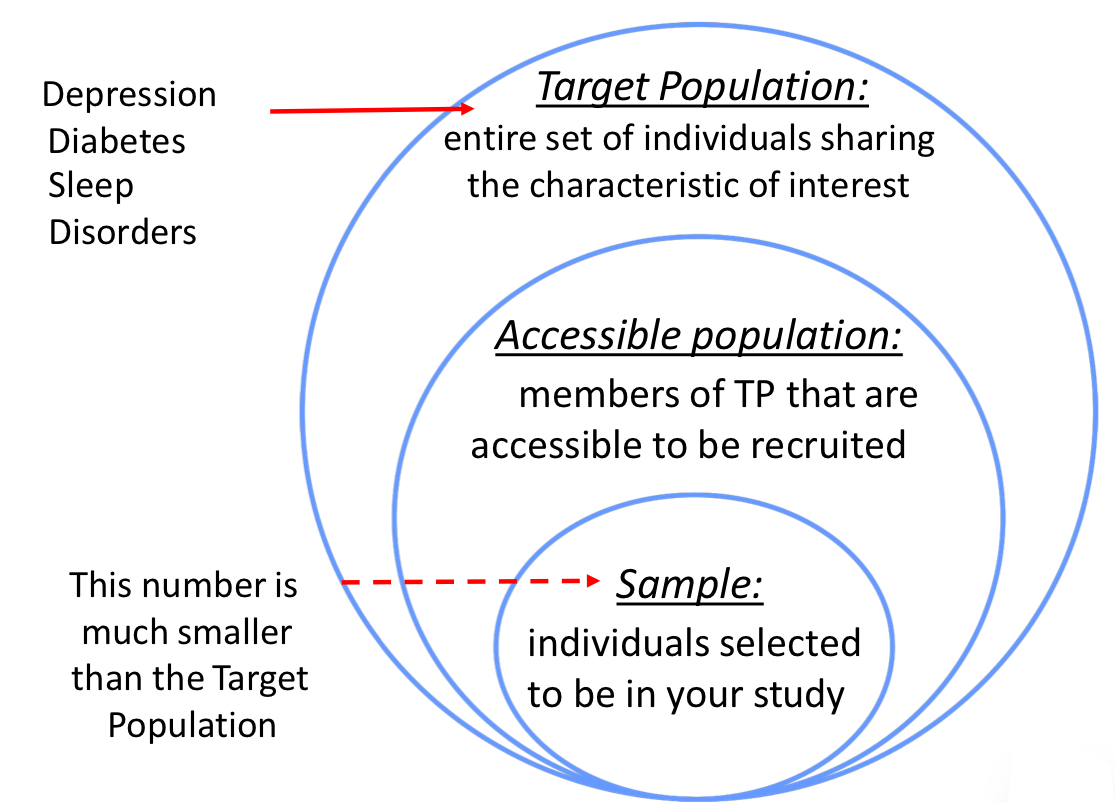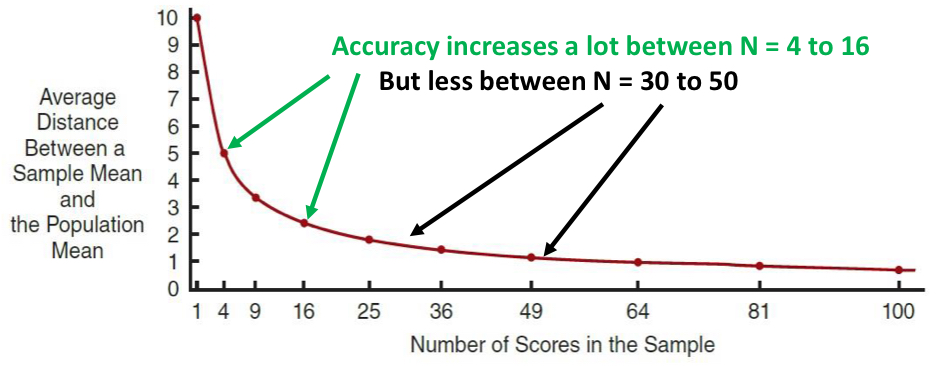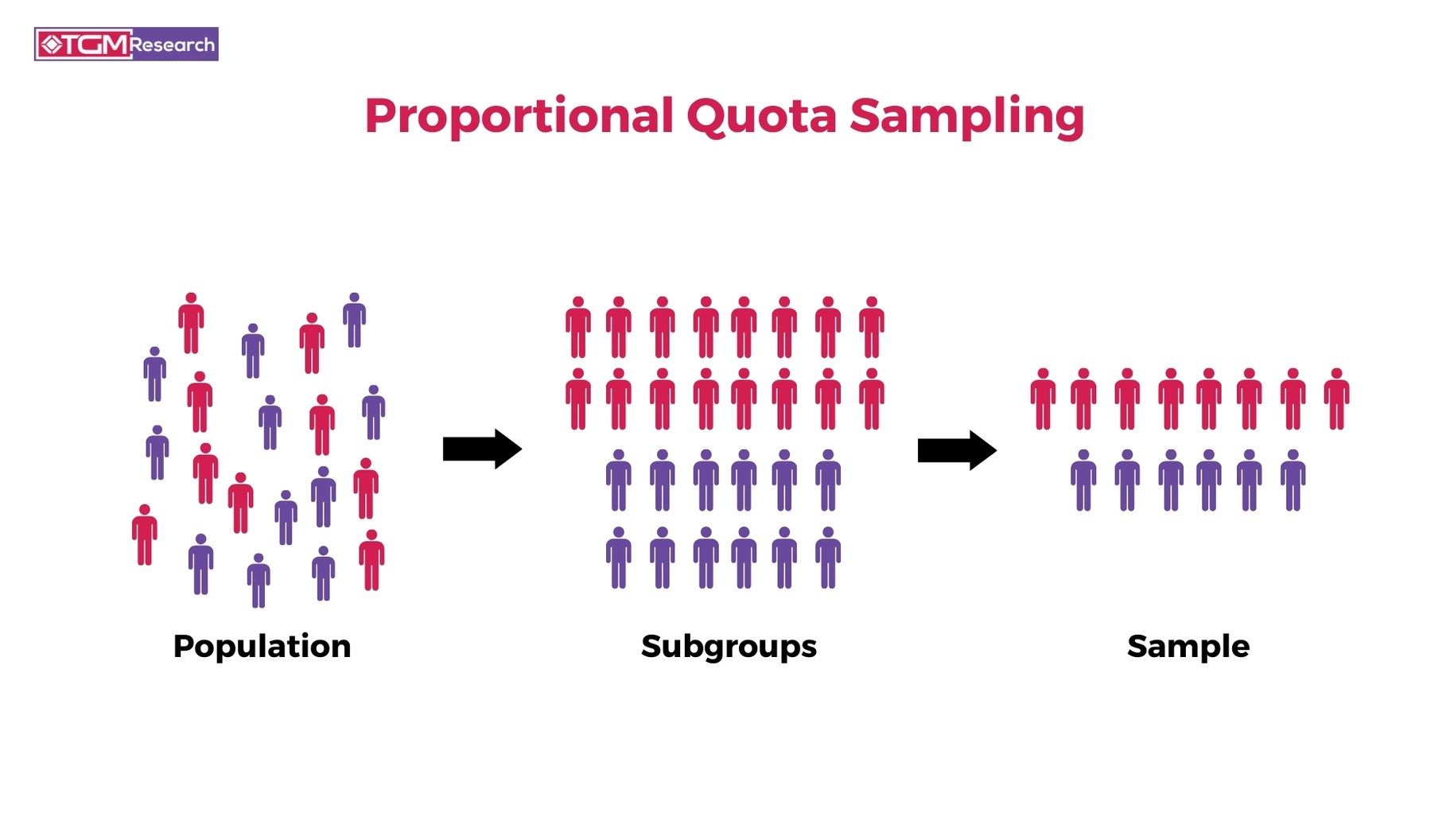Lecture 8: selecting research participants
1/63
There's no tags or description
Looks like no tags are added yet.
Name | Mastery | Learn | Test | Matching | Spaced |
|---|
No study sessions yet.
64 Terms
define “population”
a group sharing some common characteristics
define “sample”
subset of the population
define “sampling”
process of selecting participants for a research project
define “sampling error”
naturally occurring differences between the population and a sample
define “representativeness” of a sample
how closely your sample resembles the population
define “representative sample”
a sample with the same characteristics as the population
define “biased sample”
sample with different characteristics from those of the population
define “selection bias” or “sampling bias”
when participants are selected in a way that increases the probability of obtaining a biased sample
[small/big] samples have more chances of being unrepresentative of the population
small
why do we want to select samples that represent the population?
so that the study can be generalized to the population
what’s the difference between the target population, the accessible population and the sample?
target: all the individuals with the characteristic you want to study
accessible: portion of the target population, people who are accessible to be recruited
sample: people who are selected to participate

why don’t we include everyone in the population for our study? (6)
not possible
population too large
too costly
time consuming
hard
not necessary
what are some types of population records? (8)
census, residential population
census, working population
birth records
hospitalization records
education records
mobile phones
crime records
why don’t we use population records to help us sample? (3)
some population members are unknown
it can be hard to reach all members with equal probability
can be expensive and time consuming to enrol all members
true or false: the sampling is still considered random if you favour the inclusion of certain people over others
false
define “law of large numbers”
the bigger your sample size, the more accurately it will represent the population
according to the law of large numbers, how many participants should we try to recruit and why?
we try to recruit 30 participants ish
you want the sample mean to share characteristics with the population mean
as the sample size increases (x), you start to get more accuracy between the sample and the population mean
after 16 participants, it starts to plateau

ethically speaking, why shouldn’t your sample be too small or too large?
too small: not enough participants, won’t be successful → waste of resources
too large: use too many people when not needed
define “statistical power”
formula that identifies the minimum number of participants needed to detect an expected effect in a study
why do we only use statistical power in lab studies and not in surveys?
because surveys usually require more participants to get an accurate sample that reflects the population
define “probability sampling”
based on random sampling: each member of a population has equal chances of being selected
define “nonprobability sampling”
not randomly selected: each member of a population does not have equal chances of being selected
what’s the difference between probability and nonprobability sampling? (definition, randomness/bias, knowledge of population size and chances of selecting someone)
probability: everyone has equal chances of being sampled
random, less risk of a biased sample
we know the population size
we know the chances of selecting a certain participant
nonprobability: not everyone has equal chances of being sampled
not random, more chances of a biased sample
we don’t know the population size
we don’t know the chances of selecting a certain participant
for psychology, we usually us [probability/nonprobability] sampling
nonprobability as we don’t have access to population data
what are the probability sampling methods? (5) (description, strength and weakness)
simple random:
description: random process to select participants from the population
strength: fair and unbiased
weakness: not sure if sample is representative
systematic random:
description: selecting the nth participant from a list after a random start
strength: easy, representative
weakness: not independent or random
stratified random:
description: dividing population into strata and randomly selecting equal numbers from each strata
strength: all subgroups are represented
weakness: not representative because the size strata don’t represent the population
proportionate stratified random:
description: same as stratified, but each strata represents the proportion of the population
strength: good representation
weakness: some strata are harder to be represented
cluster sampling:
description: instead of sampling one by one, we sample groups that already exist
strength: quick to get large sample, easy
weakness: not much independence of score
define “cluster sampling” (description, strength, weakness)
description: instead of sampling one by one, we sample groups that already exist
strength: quick to get large sample, easy
weakness: not much independence of score
what’s the difference between stratified random sampling and proportionate stratified random sampling?
stratified: we select equal numbers from each strata for the sample
proportionate stratified: we select proportionate numbers to the population from each strata for the sample
define “combined-strategy sampling”
combining two or more sampling strategies to have a better representation of the population
explain “simple random sampling” (description, strength, weakness)
description: random process to select participants from the population, everyone has equal chances to be included
strength: fair and unbiased
weakness: not sure if sample is representative
how can simple random sampling be unrepresentative of the population?
it is unlikely, but you can have a distorted sample, especially if you have a small sample
what are the methods of random sampling? (2)
with replacement: we select and record you as a sample member and return you to the population before the next selection
without replacement: we select you and remove you from the population before the next selection
sampling with replacement is considered as [independent/non-independent] because […] while sampling without replacement is considered as [independent/non-independent] because […]
with: independent because the odds of the previous choice don’t affect the odds of the current choice (1/6 → 1/6 → 1/6)
without: non-independent because the outcome of the previous choice affects the odds of the current choices (1/6 → 1/5 → 1/4)
sampling [with/without] replacement is considered biased because […]
without
it bases you towards the next person (you had less chances in the beginning)

if we have a small population, we prefer sampling [with/without] replacement because […]
with
you want the chances of choosing someone to be consistent
why is it okay to use sampling without replacement if the population is large?
the outcome of 1÷(N-1) is pretty similar to 1÷N
bootstrapping datasets are used for sampling [with/without] replacement while cross-validation studies are used for sampling [with/without] replacement
bootstrapping: with replacement
cross-validation: without replacement
explain “systematic random sampling” (description, strength, weakness)
description: selecting the nth participant from a list after a random start have do intervals
strength: easy, representative
weakness: not independent or random
why does systematic random sampling violate independence?
because once you’ve chosen the interval and who you start with, then the entire sample is already chosen
why does systematic random sampling have a high degree of representativeness?
because it’s ordered
[simple random/systematic] sampling has higher degree of representativeness
systematic
true or false: systematic sampling is a type of simple random sampling
true: it just has a few extra rules
why is systematic sampling less random than simple random sampling?
because it violates the principle of independence (meaning that it’s less random)
explain “stratified random sampling” (description, strength, weakness)
description: dividing population into strata and randomly selecting equal numbers from each strata
strength: all subgroups are represented
weakness: not representative because the size strata don’t represent the population

explain how we do stratified sampling
identify the key strata from the population
participants are chosen by taking a random sample in each strata
we select equal numbers for each strata
we combine all the strata into one sample
explain “proportionate stratified random sampling” (description, strength, weakness)
description: same as stratified, but each strata represents the proportion of the population
strength: good representation
weakness: some strata are harder to be represented
simple random, systematic random, stratified random or proportionate stratified random: researchers test which of 3 teaching methods best increases 5th graders’ vocabulary. They identify the number of classrooms teaching each method (Method1 = 40%; Method2 = 30%; Method 3 = 30%) and sample a proportionate number of students from classes offering each method.
proportionate stratified
simple random, systematic random, stratified random or proportionate stratified random: researchers identify age-related changes in memory. They sample every 7th person from a census list of residents after choosing a random starting point until they reach 100 participants.
systematic random
simple random, systematic random, stratified random or proportionate stratified random: researchers identify age-related changes in memory. They divide a population into groups based on age (0-10; 11-20; 21-30; etc) and then choose a random sample from each of those groups.
stratified random
simple random, systematic random, stratified random or proportionate stratified random: there is a new mosquito-carried disease harming babies. Researchers have developed a new vaccine to test with babies, who are 15% of the local population. The researchers sample 100 babies from local communities to administer the vaccine.
simple random
what are the nonprobability sampling methods? (3) (description, strength and weakness)
convenience:
description: sample by selecting participants who are easy to get
strength: easy
weakness: biased
quota:
description: sample by identifying subgroups to be included and then establishing quotas each individual to be selected through convenience from each subgroup
strength: more control on the composition of a convenience sample
weakness: biased
snowball:
description: participants refer other people who are willing to participate
strength: easy
weakness: biased and less representative
define “convenience sampling” (description, strength, weakness)
description: sample by selecting participants who are easy to get
strength: easy
weakness: biased
how can convenience sampling be biased?
because it’s only composed of people who came in contact with the experimenter
how can you limit the loss of validity during convenience sampling? (2)
use a large sample with diverse people
in your report, have a detailed description of your sample so that people can make inferences about generalizability
define “quota sampling” (description, strength, weakness)
description: sample by identifying subgroups/strict numbers to be included and then establishing quotas each individual to be selected through convenience from each subgroup
strength: more control on the composition of a convenience sample
weakness: biased

explain how quota sampling is done
we identify the relevant category of people
we select a sample size for each category based on the predetermined number of participants
we establish quotas for each subgroup to reflect the population or for each subgroup to be equally represented
we recruit the participants out of convenience
what’s the difference between proportionate stratified random sampling and quota sampling?
proportionate strata: we want to perfectly represent the proportion of the population, uses random sampling
quota: we want to be as close as possible, but not perfectly, sampling isn’t random
→ both want to be representative of the population, but strata is more scientific
why isn’t quota sampling random?
because the odds of the next person being chosen depends on the quota and the proportion (still selecting by convenience)
why is quota sampling still biased?
because not everyone has the same chances of being in the sample
explain “snowball sampling” (description, strength, weakness)
description: participants refer other people who are willing to participate
strength: easy
weakness: biased and less representative
why is snowball sampling biased and not representative?
because people know each other
convenience, quota, snowball: researchers want to know whether university students are reporting higher rates of math anxiety if they are pursuing a Bachelor of Arts or a Bachelor of Science major. They offer participation for extra credit in a psychology course that enrolls students from both programs, and students sign up to participate.
convenience
convenience, quota or snowball: researchers want to know about personality differences among people who drive premium luxury cars and those who drive economical (less expensive) cars. The premium luxury car owners are harder to sample, so the researchers ask the participants in that category to refer their friends who also own luxury cars.
snowball
convenience, quota, snowball: researchers studied the prevalence of discrimination toward immigrant students in a university. In order to recruit more broadly from participants who may remain hidden to avoid discrimination, the researchers recruited family members of each participant.
snowball
convenience, quota, snowball: A researcher wants to survey individuals with different employment status on how likely they are to purchase smartphone brands. The known employment rates in the city are 90% employed and 10% unemployed. The researcher recruits 90% of their sample from employed participants and 10% from unemployed participants.
quota